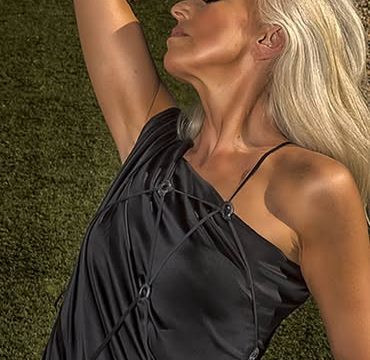In the world of television, there are many ways to capture an audience’s attention, but Albanian TV station Zjarr took an approach that sparked intense debate.
A few years ago, the channel made headlines for featuring braless news anchors, a move that stirred strong reactions and continues to divide opinions today. Was it a bold and innovative decision, or did it cross the line of professionalism?

At a time when women have fought for workplace equality, dignity, and an end to media objectification, Zjarr’s approach reignited a familiar controversy. In 2016, the station introduced a provocative format in which female anchors delivered the news wearing open jackets with nothing underneath. This decision generated widespread discussion in Albania, a small and traditionally conservative country in the Balkans.
According to the network’s owner, the strategy wasn’t just about grabbing attention—it was also symbolic, representing the country’s transition from strict censorship to media transparency.
A Controversial Approach
For over 40 years, Albania was under the rule of communist dictator Enver Hoxha, a regime marked by heavy censorship and civil oppression. When Zjarr TV introduced its unconventional news delivery style, station owner Ismet Drishti defended it as a way to challenge traditional media norms.
“In Albania, where the news is manipulated by political powers, the audience needed a medium that would present the information like it is—naked,” Drishti told AFP in 2016.
He insisted that the anchors’ appearance was not about selling sex but about promoting transparency in journalism. “We don’t sell sex; we reproduce the news as it is. It’s both symbolic and good publicity,” Drishti explained.
The model proved highly successful, and Zjarr TV even considered expanding its unique presentation style to broadcasts in English and French.
Enki Bracaj: The First Star
One of the channel’s biggest stars was 21-year-old Enki Bracaj, who hosted an international news program. With her revealing outfits and striking presence, she quickly gained a massive following, and the station saw a significant rise in ratings.
Bracaj’s decision to go braless on air was calculated. As a public relations student at a local university, she understood the importance of standing out in a competitive industry. “I simply found a way to put myself ahead,” she stated in 2016.
She even consulted her parents before accepting the job, and their support helped solidify her decision.
Crossing the Line?
However, there were limits to what Zjarr TV would tolerate. While Bracaj’s bold presentation style was initially embraced, her career at the station took a turn when she accepted a modeling offer from Playboy. This decision reportedly led to her dismissal, although she officially cited dissatisfaction with her salary as the reason for her departure.
In conservative Albania, where about 60% of the population is Muslim, nudity and even topless sunbathing remain taboo. Her move to Playboy was seen as a step too far for the station’s brand.
A New Face Takes Over
With Bracaj gone, Zjarr TV needed a new leading anchor. They found their next star in 24-year-old Greta Hoxhaj, who had spent years working in local television without much recognition.
“I worked hard for five years in local television, where I remained unnoticed,” Hoxhaj told AFP. “I regret nothing—within three months, I became a star.”
She embraced her new role, wearing a revealing pink jacket on air but dressing conservatively in her personal life. “This look is only for television,” she clarified.
Backlash and Criticism
Zjarr TV was not the first to use nudity for publicity. In Venezuela, a news site had a presenter strip to celebrate a Copa America football victory. However, the Albanian channel’s approach received widespread criticism and fueled ongoing debates about media ethics.
Online reactions were mixed. While some applauded the station’s creativity, others condemned it as unprofessional and sexist.
“It’s pathetic to have accepted such a thing just to be on screen,” one critic wrote. Another called it “outrageous” and “disgustingly sexist.”
Meanwhile, others saw no issue with it. “I see nothing wrong with this. It will make men pay more attention to the news,” one commenter remarked.
The Debate Over Women’s Attire on TV
The controversy over Zjarr TV also reignited broader discussions about how women present themselves on television. Some argued that many female TV personalities already wear overly revealing outfits, even on mainstream programs.
“There are too many women on TV whose necklines are way too low on various shows,” one person noted. “Now, I don’t care what women wear in their everyday lives, but TV should have better standards.”
However, supporters argued that viewers have the freedom to change the channel. “There is a diversity of choice, and everyone is free to watch what they want,” said Leonard Olli, a journalist and PR specialist in Tirana.
A Divided Reaction
While feminist groups and journalist associations in Albania largely remained silent on the matter, Aleksander Cipa, President of the Union of Albanian Journalists, voiced his concerns. “Nudity cannot resolve the crisis in the media, which will do anything to survive,” he stated.
Despite the backlash, Hoxhaj, the new face of Zjarr TV, remained unfazed. “What matters to me is that I’m doing well, both in my work and in my newfound fame,” she said.
In her community, she enjoys strong support. “I receive countless messages from viewers who appreciate my work. And I never run out of bouquets of flowers—not even twice a week!” she added with a smile.
Final Thoughts
Whether viewed as an innovative media experiment or a blatant publicity stunt, Zjarr TV’s bold strategy left a lasting impression. While some see it as a step forward for transparency, others believe it undermines the credibility of journalism. Regardless, it’s clear that the debate over professionalism and entertainment in news broadcasting is far from over.





